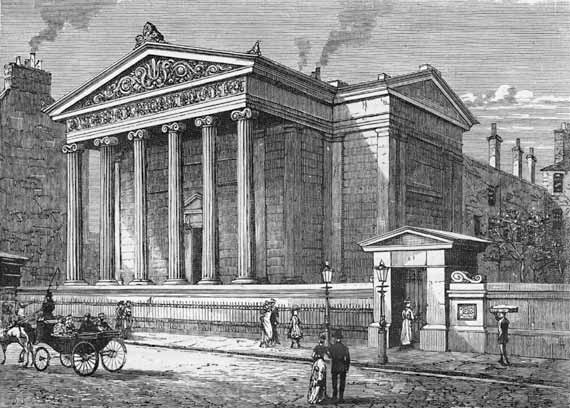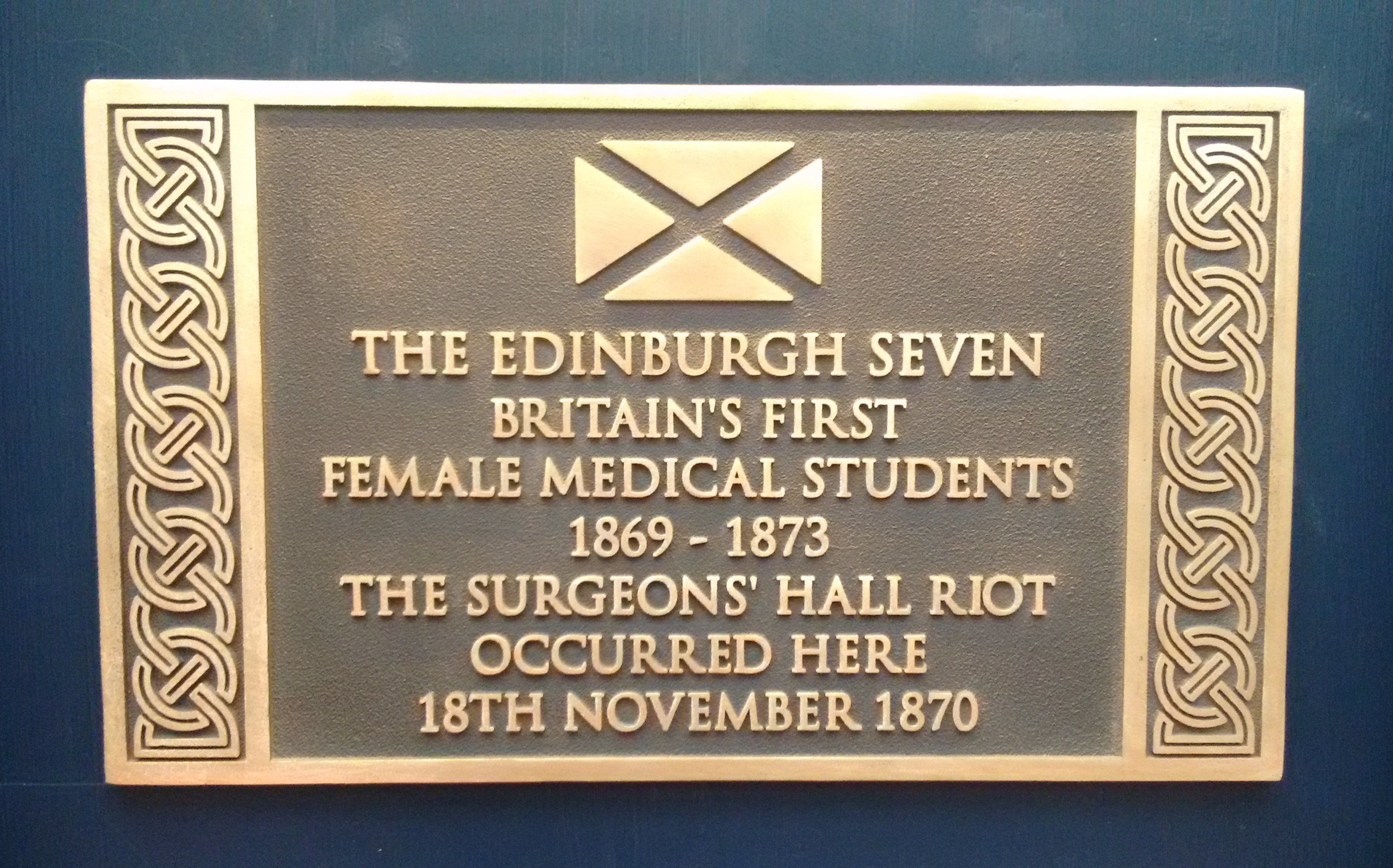Surgeons' Hall Riot on:
[Wikipedia]
[Google]
[Amazon]
 The Surgeons' Hall Riot (18 November 1870) was a defining moment in the campaign of the
The Surgeons' Hall Riot (18 November 1870) was a defining moment in the campaign of the
 The riot represented the culmination of months of harassment and bullying that the women faced during their studies; they had obscenities shouted at them in the streets, doors slammed in their face, and dirty or threatening letters were sent to them as part of this campaign of abuse. After the event, Sophia Jex-Blake was to claim that responsibility for inciting the riot lay with a student named Mr Craig, which led to his filing a defamation writ against her in January 1871. It has further been suggested that the students who instigated or took part in the riots did so with the support of medical faculty, particularly from Professor
The riot represented the culmination of months of harassment and bullying that the women faced during their studies; they had obscenities shouted at them in the streets, doors slammed in their face, and dirty or threatening letters were sent to them as part of this campaign of abuse. After the event, Sophia Jex-Blake was to claim that responsibility for inciting the riot lay with a student named Mr Craig, which led to his filing a defamation writ against her in January 1871. It has further been suggested that the students who instigated or took part in the riots did so with the support of medical faculty, particularly from Professor  Jex-Blake defended herself against Craig's writ of defamation in court with her colleagues serving as witnesses, and although the court found in favour of the claimant they awarded him just one farthing instead of the £1000 he had requested; the result has since been described as a victory for the Edinburgh Seven. Following the riots, the media condemned the actions of the rioters, with ''The Scotsman'' writing of the event:
Jex-Blake defended herself against Craig's writ of defamation in court with her colleagues serving as witnesses, and although the court found in favour of the claimant they awarded him just one farthing instead of the £1000 he had requested; the result has since been described as a victory for the Edinburgh Seven. Following the riots, the media condemned the actions of the rioters, with ''The Scotsman'' writing of the event:

 The Surgeons' Hall Riot (18 November 1870) was a defining moment in the campaign of the
The Surgeons' Hall Riot (18 November 1870) was a defining moment in the campaign of the Edinburgh Seven
The Edinburgh Seven were the first group of matriculated undergraduate female students at any British university. They began studying medicine at the University of Edinburgh in 1869 and, although the Court of Session ruled that they should neve ...
, a group of women fighting for the right to train and practice as doctors. It created a groundswell of support for the women's campaign, and also led to a well documented libel case against Sophia Jex-Blake
Sophia Louisa Jex-Blake (21 January 1840 – 7 January 1912) was an English physician, teacher and feminist. She led the campaign to secure women access to a University education when she and six other women, collectively known as the Edinb ...
.
The riot
On 18 November 1870, the women were to attend an anatomy exam atSurgeons' Hall
Surgeons' Hall in Edinburgh, Scotland, is the headquarters of the Royal College of Surgeons of Edinburgh (RCSEd). It houses the Surgeons' Hall Museum, and the library and archive of the RCSEd. The present Surgeons' Hall was designed by William ...
in Edinburgh. As they approached the building, they were confronted by a large crowd of students and several hundred onlookers. They were verbally abused and pelted with refuse, and the gate to the building was slammed in their face. They were eventually able to gain access to the hall — some resources state that access was facilitated by helpful janitorial staff, while others assert that the women were assisted by sympathetic male students. Several disruptive students were ejected from the building to allow the examination to proceed, however it was further interrupted when a live sheep — the pet sheep of the college known as "Poor 'Mailie" — was let loose in the room through a back door. After the close of the examination, a group of Irish students known as the "Irish Brigade" escorted the women out of the college in safety, although they were by this time well spattered with mud.
Aftermath
 The riot represented the culmination of months of harassment and bullying that the women faced during their studies; they had obscenities shouted at them in the streets, doors slammed in their face, and dirty or threatening letters were sent to them as part of this campaign of abuse. After the event, Sophia Jex-Blake was to claim that responsibility for inciting the riot lay with a student named Mr Craig, which led to his filing a defamation writ against her in January 1871. It has further been suggested that the students who instigated or took part in the riots did so with the support of medical faculty, particularly from Professor
The riot represented the culmination of months of harassment and bullying that the women faced during their studies; they had obscenities shouted at them in the streets, doors slammed in their face, and dirty or threatening letters were sent to them as part of this campaign of abuse. After the event, Sophia Jex-Blake was to claim that responsibility for inciting the riot lay with a student named Mr Craig, which led to his filing a defamation writ against her in January 1871. It has further been suggested that the students who instigated or took part in the riots did so with the support of medical faculty, particularly from Professor Robert Christison
Sir Robert Christison, 1st Baronet, (18 July 1797 – 27 January 1882) was a Scottish toxicologist and physician who served as president of the Royal College of Physicians of Edinburgh (1838–40 and 1846-8) and as president of the British ...
, for whom Craig worked as class assistant and who was explicitly opposed to the presence of women in medicine.
 Jex-Blake defended herself against Craig's writ of defamation in court with her colleagues serving as witnesses, and although the court found in favour of the claimant they awarded him just one farthing instead of the £1000 he had requested; the result has since been described as a victory for the Edinburgh Seven. Following the riots, the media condemned the actions of the rioters, with ''The Scotsman'' writing of the event:
Jex-Blake defended herself against Craig's writ of defamation in court with her colleagues serving as witnesses, and although the court found in favour of the claimant they awarded him just one farthing instead of the £1000 he had requested; the result has since been described as a victory for the Edinburgh Seven. Following the riots, the media condemned the actions of the rioters, with ''The Scotsman'' writing of the event:
''...a certain class of medical students are doing their utmost to make sure that the name of medical student synonymous with all that is cowardly and degrading, it is imperative upon all...men...to come forward and express... their detestation of the proceedings which have characterised and dishonoured the opposition to ladies pursuing the study of medicine in Edinburgh...''The riots and their negative portrayal in the national media subsequently led not only to increased awareness of the Edinburgh Seven, but to a rise in public sympathy for the women and their fight to study medicine.

Commemoration plaque
In September 2015 aHistoric Scotland
Historic Scotland ( gd, Alba Aosmhor) was an executive agency of the Scottish Office and later the Scottish Government from 1991 to 2015, responsible for safeguarding Scotland's built heritage, and promoting its understanding and enjoyment. ...
plaque commemorating the riot was unveiled at the University of Edinburgh. The nomination for the plaque was made by Learning Technology Senior Advisor Jo Spiller, of the University of Edinburgh. It was unveiled by Fiona Hyslop
Fiona Jane Hyslop (born 1 August 1964) is a Scottish politician who served as Cabinet Secretary for Economy, Fair Work and Culture from 2020 to 2021. A member of the Scottish National Party (SNP), she has been a Member of the Scottish Parliamen ...
(Cabinet Secretary for Culture, Europe and External Affairs for the Scottish Government at the time), at a ceremony which was held at the University's Anatomical Museum.
The riot in popular culture
In September 2015, the riot was included in Wendy Carle Taylor's musical show ''What a Riot! A Celebration of Surgeons' Hall in Story & Song'', performed at the Surgeons' Hall Museum. The show was staged in celebration of the re-opening of the museum following refurbishment.References
{{reflist History of the University of Edinburgh Alumni of the University of Edinburgh History of medicine in the United Kingdom